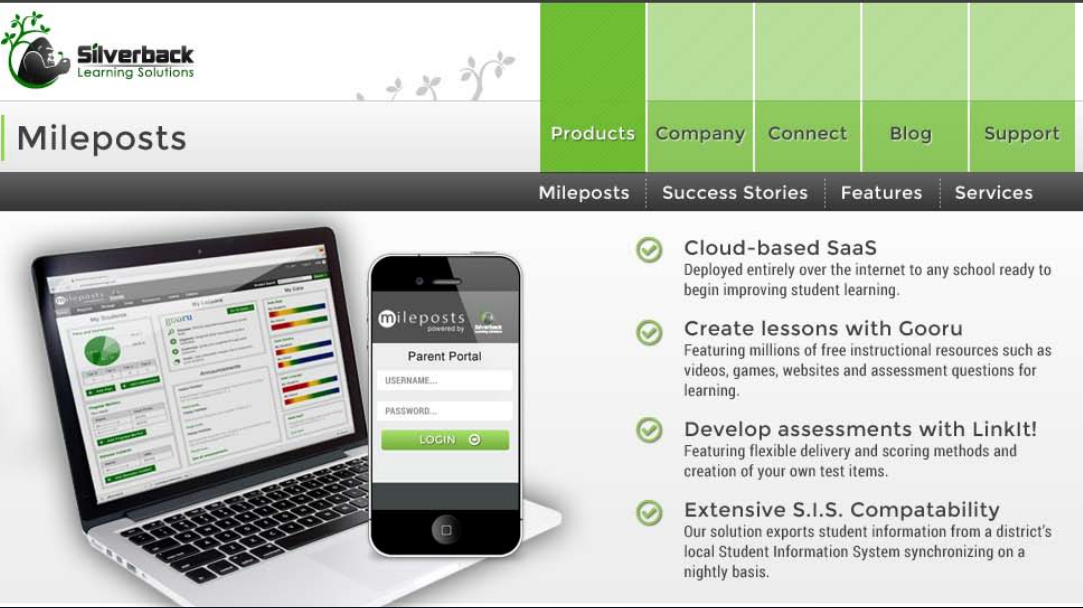Jim Lewis is an unlikely software CEO.
But the retired Blaine County superintendent now works out of third-floor offices near the Boise River Greenbelt. His Silverback Learning Solutions offers school districts a system to track student growth — and determine the teaching and intervention methods that work, or don’t work.
His 3-year-old company is making inroads in a crowded sector. Nearly 80 school districts are using Silverback’s Mileposts system, and Lewis believes the company is poised to compete for statewide contracts.
Perhaps most telling is Silverback’s market share close to home. In Idaho, 34 districts are spending thousands of dollars a year to use Mileposts, even as the state pilots a free system.
The system’s origins

Mileposts grew out of a brainstorming process that began early in Lewis’ decade as Blaine County superintendent.
In 2002, Lewis assembled a task force of teachers and administrators to brainstorm ways to improve student performance — and tailor learning for English language learners, special education students and gifted and talented students alike. “Our whole philosophy was, ‘Let not one child slip through the cracks. Not one.’”
Among the ideas that morphed out of the brainstorming process: create a complete but easy-to-use computer system that tracks student progress. A team of software designers was paired with a team of educators.
They were told to create a system that provides a complete view of a student’s academic history, so a teacher could make the most of the 180-day school year.

If a student had blossomed or struggled under an intervention plan during fourth grade, a fifth-grade teacher would be able to access this information before the first day of class. The system would even make note of things that might seem trivial. If a seventh-grader had poor eyesight and didn’t like to wear glasses, eighth-grade teachers would know they should seat this student at the front of the class from day one.
They were also told to create a system teachers could update in real time. If a student was struggling because of absences, teachers would be able to identify the holes in his or her command of a subject.
The central idea was to keep struggling students in the mainstream and out of costly and unneeded special education. When Mileposts was launched in 2004, Blaine County’s special education rate was 11.75 percent. By 2009, it was 9.5 percent.
Branching out
By 2009, as Lewis was getting ready to retire, Blaine County was getting ready to test Mileposts elsewhere. Blaine County partnered with six other districts: larger districts such as Twin Falls, small rural districts such as Castleford. Caldwell was sought out because, like Blaine County, the district has a significant Latino community.
Mileposts doesn’t come for free. Idaho districts have to pay $5 per student per year — although this is significantly less than the $9 to $12 per year charged to out-of-state districts.
For Gooding Superintendent Heather Williams, the program is well worth $6,000 a year. She says Mileposts helps the district make better teaching decisions, and not just at the student level. It makes it easier to spot classroom and buildingwide trends — an intervention plan or a facet of the curriculum that is working, or not working. The district can share successes, and ditch programs that don’t get results.
Twin Falls Superintendent Wiley Dobbs said he’d considered dropping Mileposts, which costs his district $40,000 a year, and switching to the free Schoolnet system the state is rolling out on a pilot basis. But Schoolnet could not provide the same ready access to student information, and the district stood pat. The district will keep Mileposts, Dobbs said, “until something can take its place, and we can have confidence in that something.”
One pilot district, Shoshone, dropped Mileposts a year ago. The district was happy with the system, Superintendent Rob Waite said, but couldn’t justify the costs. But Shoshone has had problems with Schoolnet, and Waite says his small district is building spreadsheets in house.
Meanwhile, the Bonneville School District tried Schoolnet a year ago, but spent $55,000 this year to move to Mileposts. The district’s problem isn’t with Schoolnet itself; the problem is that the districts feed data to Schoolnet through the state, and it can take weeks for new data to come back to classroom teachers.
“The state has a solution coming down the road, but it isn’t here now,” Bonneville superintendent Chuck Shackett said. “We can’t get local benchmark assessments into Schoolnet for teachers to see. With Mileposts, we get a comprehensive view of every student.”
In competition?

In the arcane — and crowded — educational management software sector, Schoolnet is an established name. And when Idaho went software shopping in 2010, Blaine County was just entering a partnership to share the Mileposts software. Silverback didn’t even venture into the market until 2011.
“I think the state made the right decision in choosing Schoolnet,” said Lewis.
Stan Olson is equally succinct. The former Boise School District superintendent, who joined Silverback after a failed run for state schools superintendent, said the state simply went with an industry leader. “Nobody ever got fired for hiring IBM,” said Olson, Silverback’s director of business development.
But at this point, the J.A. and Kathryn Albertson Foundation is surveying Idaho educators about Schoolnet, after helping to pay for the system through a three-year, $21 million grant. And three years after his department chose Schoolnet, Superintendent of Public Instruction Tom Luna isn’t choosing sides.
“I am supportive of local school districts implementing instructional management systems that offer teachers tools like digital content, lesson plans, assessments, and most importantly student achievement data,” Luna said in a prepared statement. “Whether a district chooses to use Mileposts, Schoolnet or any other instructional management system, the most important element is that it is being utilized to customize education for every child.”
Lewis describes Silverback as a “digital disruption company,” and says big-box software vendors are going by the wayside. But he also downplays the notion of competition with Schoolnet, and says he is just trying to build a company that works well with school districts. “We’re very comfortable with that.”
Disclosure: Idaho Education News is funded through a grant from the J.A. and Kathryn Albertson Foundation.
